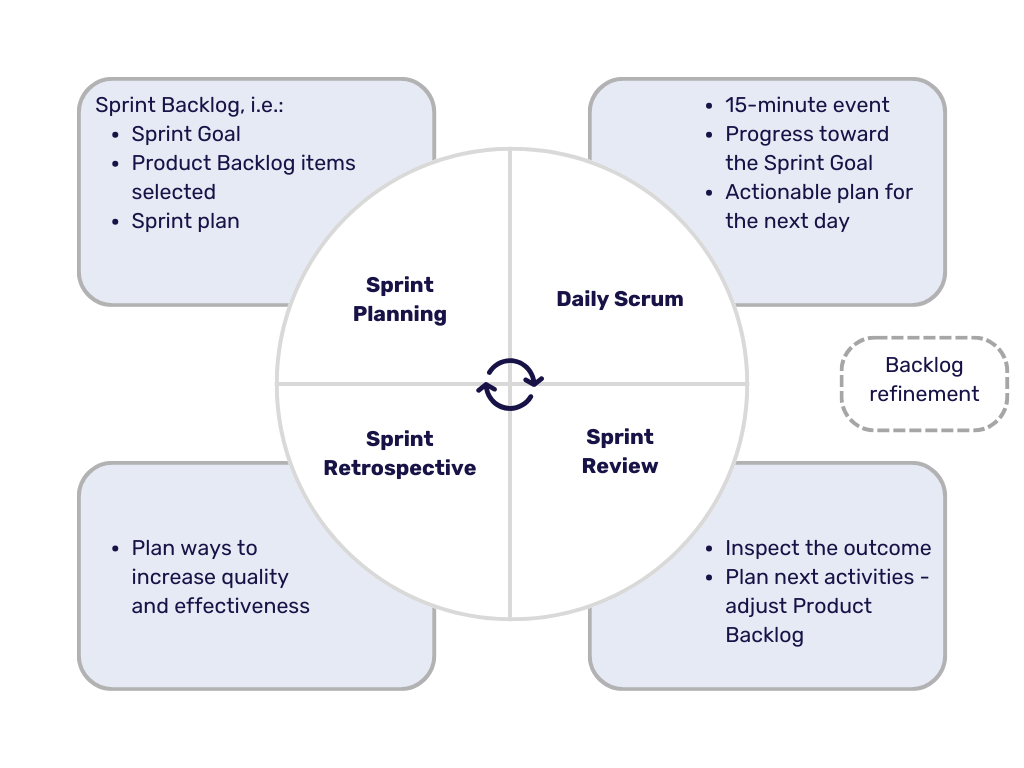
Exploring Scrum Methodologies
Author: Kysha Praciak
· 3 mins readScrum Methodologies in Software Development
In this blog, we will explore various Scrum methodologies, which is a popular agile framework utilized in software development. Scrum is a flexible and simple process framework that enables teams to work collaboratively and deliver incremental value. It offers adequate structure to teams to incorporate their work processes while implementing the best practices to optimize their specific needs. We will also discuss the benefits of using Scrum in software development, the five Scrum values, and the various Scrum metrics that teams can leverage to measure their performance and enhance their efficiency.

Scrum Methodologies
Scrum has several methodologies that are used in software development. Some of the most commonly used methodologies include:
- Scrum Framework: This is the most popular Scrum methodology. It is a lightweight process framework that is used to manage complex software and product development. The Scrum Framework consists of three roles: Product Owner, Scrum Master, and Development Team.
- Scrum of Scrums: This methodology is used when multiple Scrum teams are working on the same project. It is a way to coordinate the work of multiple Scrum teams to ensure that they are working towards the same goal.
- Large-Scale Scrum (LeSS): This methodology is used when there are more than eight members in a Scrum team. It is a way to scale Scrum to large projects and organizations.
Benefits of Scrum Methodologies
Scrum methodologies have several benefits in software development. Some of the benefits include:
- Increased productivity: Scrum methodologies help teams to work more efficiently and effectively. This leads to increased productivity and faster delivery of products.
- Improved quality: Scrum methodologies help teams to focus on quality throughout the development process. This leads to higher quality products and fewer defects.
- Better communication: Scrum methodologies promote better communication between team members, stakeholders, and customers. This leads to better collaboration and a better understanding of the project requirements.
- Better sprint planning: Scrum methodologies help teams to plan their sprints more effectively. This leads to better time management and more efficient use of resources.
Scrum Values
The five Scrum values are Courage, Focus, Commitment, Respect, and Openness. These values are essential to the success of Scrum teams. They help to create a culture of trust, collaboration, and continuous improvement. Here’s a brief overview of each value:
- Courage: Scrum team members need courage to do the right thing and face tough problems. For example, they should exhibit courage to explore the unknown, to change direction, to share information, and to engage in courteous disagreements.
- Focus: The Scrum team focuses on the work of the Sprint and its goals. Examples of this include focusing on creating value, what’s currently most important, and getting to Done.
- Commitment: Each Scrum team member commits to achieving the team’s goals and to support each other. This involves commitment or dedication to delivering value, quality, working toward the Sprint and Product Goals, and using empiricism.
- Respect: It’s necessary for Scrum team members to respect each other as skilled professionals. Scrum Team members should respect each other’s differing expertise and perspectives and be respectful when they disagree.
- Openness: The Scrum Team and its stakeholders agree to be open about all of the work and the challenges with performing the work. Scrum Team members should be open about the struggles they face. They should share feedback and learn from each other and from their stakeholders.
To learn more about Scrum values, you can refer to Vollcom Digital’s article on Scrum Values.
Scrum Metrics
Scrum teams can use various metrics to measure their performance and improve efficiency. Some of the commonly used metrics include:
- Velocity: This metric measures the amount of work a team can complete in a Sprint.
- Sprint Burndown: This metric tracks the amount of work remaining in a Sprint.
- Release Burndown: This metric tracks the amount of work remaining in a release.
- Sprint Retrospective: This metric is used to review the previous Sprint and identify areas for improvement.
To learn more about Scrum metrics, you can refer to Vollcom Digital’s article on Scrum Metrics.
Summary
Scrum methodologies are widely used in software development due to their many benefits. They help teams to work more efficiently and effectively, focus on quality, and promote better communication. The five Scrum values are essential to the success of Scrum teams. They help to create a culture of trust, collaboration, and continuous improvement. Scrum teams can use various metrics to measure their performance and improve efficiency. By using Scrum methodologies, teams can deliver value incrementally in a collaborative way and achieve their goals more effectively.





Share